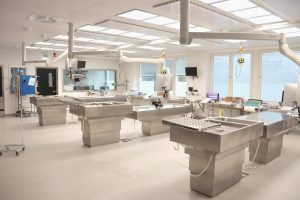
Research at the Department of Forensic Medicine
merResearch at the Department of Forensic Medicine aims to promote legal certainty by securing and improving the scientific basis for medico-legal investigations. To accomplish this, the department has three areas of focus; clinical forensic medicine, medico-legal death investigations, and medical age assessments. The department’s researchers and research-students drive and participate in projects spanning various research areas.
Click here to email the forensic department’s research coordinator Nina Heldring.
Research Areas
Postmortem Diagnostics
Medico-legal death investigations are based on macroscopic and microscopic examinations combined with toxicological and biochemical analyses. Research in postmortem diagnostics aims to improve medico-legal death investigations and is divided into five research fields.
Postmortem Biochemistry
Research to identify biochemical markers that can be used to determine causes of death has been an active research area for many years. Analyses of body fluids and tissues are, for instance, a natural component of medico-legal investigations into suspected addiction problems, diabetes, infections, or anaphylactic shock. However, the use of biochemical markers is limited by the fact that clinical reference values are not applicable due to natural changes that occur after death. Today, projects are underway to identify postmortem markers specific to conditions such as traumatic brain injury, acute cardiac death, and asphyxia.
Postmortem Systems Biology
Research in postmortem systems biology is conducted in a collaborative research group with members from the forensic chemistry and forensic medicine departments. The research aims to identify characteristic profiles of metabolic products (so-called metabolomics) that can be linked to specific causes of death or poisonings. The research utilises surplus data generated from toxicological analysis of blood samples, which are processed using multivariate analysis methods to create hypothesis-testing statistical models.
Postmortem Morphology
To determine if certain autopsy findings are relevant to specific causes of death or manners of death, associations need to be carefully evaluated. Research is ongoing on macroscopic and microscopic findings that can be used to support the diagnosis of, for example, drowning, haemorrhage, or alcohol dependence. The research also includes the evaluation of imaging diagnostics using computed tomography.
Forensic Anthropology and Taphonomy
By analysing skeletons and other biological markers, the identification of human remains can be facilitated, as well as the assessment of age, sex, height, possible injuries and diseases, and circumstances surrounding death (forensic anthropology). This information is important for police investigators and affected families. Research at the department focuses on analysing carbon-14 and carbon-13 in various bone fractions to improve the possibilities of estimating an unidentified person’s origin, year of birth, and year of death, as well as evaluating other methods that can facilitate identification work. Research is also being conducted in forensic taphonomy (i.e., the study of changes that occur after death) to develop quantitative methods for better assessing how long a person has been deceased and to guide search efforts for deceased persons.
Forensic Epidemiology
The National Board of Forensic Medicine has a unique library of material that can be used for epidemiological research. Analysis of such data may generate pivotal knowledge for policymakers to guide preventive measures and other societal functions. The research includes a focus on mapping the incidence, risk groups and risk behaviours associated with, for example, accidental drownings or poisonings.
Clinical Forensic Medicine
Clinical forensic medicine encompasses forensic assessments on living individuals. Medical age assessments are carried out to estimate the age of an individual whose date of birth is uncertain or disputed. In cases of suspected violent crimes, forensic examinations are performed to document the appearance and location of injuries that can be used as evidence in police investigations. Ongoing research in clinical forensic medicine is presented below.
Medical Age Assessments
Medical age assessments are commonly used in legal, migration, and humanitarian contexts where an individual’s age is relevant in determining entitlement to certain rights, benefits, or legal processes. No method for medical age assessments can determine the exact age of an individual. Research projects are underway to develop statistical models and machine learning algorithms with the aim of improving and streamlining assessments. In addition, research projects focusing on investigating how well specific molecular signatures can be linked to specific ages are ongoing.
Infant Abuse and External Factors in Infant Deaths
For infants with potential injuries and infant deaths, a forensic examination is always performed, and research is ongoing with the aim to improve assessments and identify factors that could be targeted for prevention. Questions that research on infant abuse seeks to answer include, for example, what is the mechanistic explanation for certain findings in infants and whether and when findings are caused by medical conditions or abuse.
Injury Patterns in Abuse and Lethal Violence
Injury patterns in lethal violence or abuse are crucial for forensic pathologists’ assessments of injuries. Research in this area aims to systematically map injury patterns that can be linked to different types of violence, such as firearm violence, sharp or blunt force trauma, and whether the injuries are self-inflicted or inflicted by another person. The overall aim of the research is to increase knowledge about different types of violence that cause injuries and to map factors that affect assessments.
